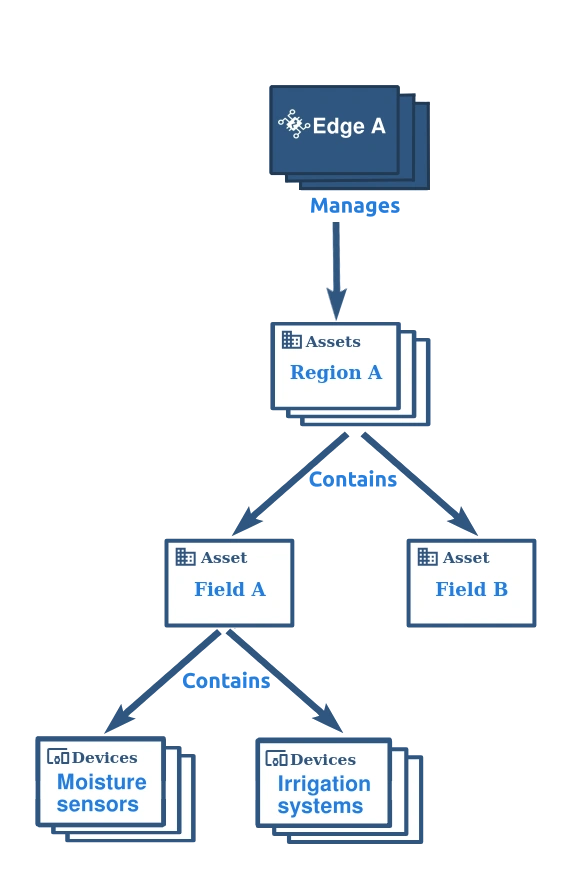Entities Overview
In ThingsBoard, an entity is a core component that represents a physical object or a concept within the platform. You can view the list of ThingsBoard entities here.
ThingsBoard Edge supports entities that are relevant for edge computing.
Available Edge Entities
- Devices: Physical IoT devices (sensors, actuators, controllers).
- Assets: A real world object that helps group and manage the IoT ecosystem (e.g., machines, buildings, factories).
- Customers: Organizations or users assigned to specific devices/assets.
- Users (for PE): People who manage and interact with edge resources.
- Entity Views: Predefined views of selected entity data.
- Alarms: Alerts for anomalies or predefined conditions.
- Dashboards: Visualizations of telemetry and device data.
- Rule Chains: Local data processing and automation logic.
Most entities can be created on the Edge, except for Customers, and Users entities. These entities can be created on the Server and then assigned to the Edge instance.
The Devices and Assets entities have the configuration templates as Device Profiles and Asset Profiles, respectively.
Entity Key Features
Attributes
Attributes are the structured data that can be associated with the entities (e.g., device model, location, token). They are stored in the local database and can be used for visualization, analysis, logic configuration, and integration with other services.
For a comprehensive understanding of the ThingsBoard attributes, please refer to the Working with IoT Attributes documentation. You can also refer to the Edge Attributes article to review the attributes specific to Edge.
Telemetry
Telemetry refers to time-series data collected from IoT devices and processed by the Rule Chain.
Telemetry is stored as key-value pairs:
- Key: A telemetry field (e.g., temperature, humidity, voltage).
- Value: A numerical or string value (e.g., 25.4°C, 45%, “ON”).
Example:
1
2
3
4
5
{
"temperature": 25.4,
"humidity": 45,
"status": "ON"
}
You can learn more about working with telemetry data here.
By default, ThingsBoard Edge synchronizes telemetry data with the ThingsBoard Cloud. During an internet outage, telemetry is stored locally and sent to the Cloud once the connection is restored.
Relations
The relation feature defines connections between entities and helps to model the real-world hierarchy between physical objects.
Several parameters define the relation hierarchy between the entities:
- Direction: Describes how the entities are associated with each other.
- “Outbound relation - From”: Indicates that the relation originates from the entity (the entity is a source).
- “Inbound relation - To”: Indicates that the relation points to the entity (the entity is a recipient).
- Relation type: Describes the nature of the connection between the entities.
- “Contains”: Indicates that the entity is a part of another entity (e.g., Device A is the part of Asset A).
- “Manages”: Indicates that the entity is responsible for another entity (e.g., Asset A manages Device A).
The entity relations diagram can appear as follows:

Next steps
-
Getting started guide - Provide quick overview of main ThingsBoard Edge features. Designed to be completed in 15-30 minutes:
-
Installation guides - Learn how to setup ThingsBoard Edge on various available operating systems and connect to ThingsBoard Server.
-
Edge Rule Engine:
-
Rule Chain Templates - Learn how to use ThingsBoard Edge Rule Chain Templates.
-
Provision Rule Chains from cloud to edge - Learn how to provision edge rule chains from cloud to edge.
-
- Security:
- gRPC over SSL/TLS - Learn how to configure gRPC over SSL/TLS for communication between edge and cloud.
-
Features:
-
Edge Status - Learn about Edge Status page on ThingsBoard Edge.
-
Cloud Events - Learn about Cloud Events page on ThingsBoard Edge.
-
-
Use cases:
-
Manage alarms and RPC requests on edge devices - This guide will show how to generate local alarms on the edge and send RPC requests to devices connected to edge:
-
Data filtering and traffic reduce - This guide will show how to send to cloud from edge only filterd amount of device data:
-
- Roadmap - ThingsBoard Edge roadmap.